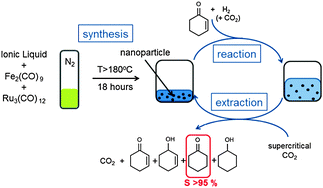Selective hydrogenation of cyclohexenone on iron–ruthenium nano-particles suspended in ionic liquids and CO2-expanded ionic liquids
Abstract
Iron and ruthenium mono- and

* Corresponding authors
a
Department of Chemistry and Applied Biosciences, ETH Zurich, Hönggerberg, HCI, Switzerland
E-mail:
baiker@chem.ethz.ch
Fax: +41 44 632 1163
Tel: +41 44 632 3153
b Chemistry Department, Faculty of Science, King Abdulaziz University, Jeddah 21589, Saudi Arabia
Iron and ruthenium mono- and

 Please wait while we load your content...
Something went wrong. Try again?
Please wait while we load your content...
Something went wrong. Try again?
J. Andanson, S. Marx and A. Baiker, Catal. Sci. Technol., 2012, 2, 1403 DOI: 10.1039/C2CY00533F
To request permission to reproduce material from this article, please go to the Copyright Clearance Center request page.
If you are an author contributing to an RSC publication, you do not need to request permission provided correct acknowledgement is given.
If you are the author of this article, you do not need to request permission to reproduce figures and diagrams provided correct acknowledgement is given. If you want to reproduce the whole article in a third-party publication (excluding your thesis/dissertation for which permission is not required) please go to the Copyright Clearance Center request page.
Read more about how to correctly acknowledge RSC content.
 Fetching data from CrossRef.
Fetching data from CrossRef.
This may take some time to load.
Loading related content
